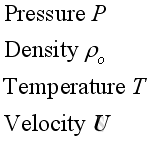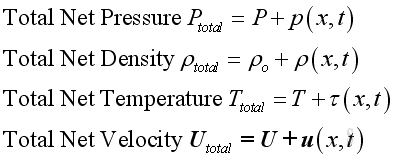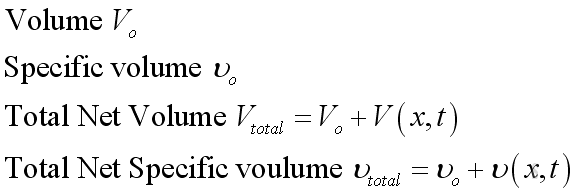Content
Acoustic Propagation
Acoustic Fluctuation
Acoustic Propagation
Consider a longitudinal sound wave traveling along a direction in a fluid, the acoustic disturbance propagation causes medium particle displacement in form of oscillation, and the medium particles return to its former state after the disturbance has passed.
The fluid in most common engineering acoustic system can be assumed as an idea gas, and obey the perfect gas law. That is
 or
or
 or
or
 or
or
 or
or

where
P is pressure
ρ is density of medium
Rs is specific gas constant of medium
T is absolute temperature
υ is specific volume
V is volumn of medium
m is mass of medium
n is mass of medium
R is universal gas constant
M is number of moles of medium
In equilibrium state, the perfect gas equation is still valid under the sound propagation process.
To simplify the problem, the fluid medium is assumed to be homogeneous and isotropic that properties of the medium are same everywhere. The medium is also assumed to be perfect elastic for the sound wave propagation with no energy loss. The fluid is also assumed as an inviscid fluid with no drag force. As the fluid medium is in equilibrium, the gravitational effects on sound propagation can also be neglected.
Since the acoustic oscillations are very small, the temperature gradients due to the oscillation is very small also. Nearly no heat can be transferred to other medium particle during the sound propagation process. Therefore the wave propagation process can be assumed to be adiabatic and reversible, an isentropic process. For adiabatic process, the relation of pressure and density is:
 or
or

where
P is pressure
α is constant
γ is adiabatic index of medium
υ is specific volume
The relationship of pressure and density due to sound wave is non-linear, but this non-linearity effect is usually negligible when comparing with the sound perception of ear. When the fluctuations of medium particle are small, e.g. less than 100dB, the acoustic properties can be assumed linear.
Acoustic Fluctuation
At initial equilibrium ambient state, the medium is assumed to be homogeneous
and quiescent. The physical properties are independent of position and time. The
initial medium velocity also equals to zero (
 ) and the physical properties are
defined as:
) and the physical properties are
defined as:

At the acoustic static, assuming there is no mass entering or leaving the system for the sound propagation, the acoustic disturbance will alter the physical properties of medium and can be defined as:

where
 is the acoustic pressure variations
is the acoustic pressure variations
 is the acoustic density variations
is the acoustic density variations
 is the acoustic temperature variations
is the acoustic temperature variations
 is the acoustic velocity variations
is the acoustic velocity variations
The acoustic fluctuation is a function of traveling distance and time. The fluid returns to its former equilibrium state after the disturbance has passed.
Besides, the representation of corresponding volume or specific volume of medium are:

where
Vo is the initial volume of medium
υo is the
initial specific volume of medium
 is the acoustic volumetric variations
is the acoustic volumetric variations
 is the acoustic specific volume variations
is the acoustic specific volume variations
©sideway
ID: 100900017 Last Updated: 9/14/2010 Revision: 1 Ref:
References
- Michael P. Norton; Denis G. Karczub,, 2003, Fundamentals of Noise and Vibration Analysis for Engieer
- G. Porges, 1977, Applied Acoustics
- Douglas D. Reynolds, 1981, Engineering Principles of Acoustics:; Noise and Vibration Control
- Conrad J. Hemond, 1983, Engineering Acoustics & Noise Control
- F. Fahy, 2001, Foundations of Engineering Acoustics
- D.A. Biew; C.H. Hansen, 1996, Engineering Noise Control: Theory and Practice
Latest Updated Links
- Travel Singapore Sight Space(last updated On 12/30/2025)
- Travel Singapore Sight Curiosity Cove(last updated On 12/30/2025)
- Travel Singapore Sight Night Safari(last updated On 12/30/2025)
- Travel Singapore Sight River Wonders(last updated On 12/30/2025)
- Travel Singapore Sight Rainforest Wild ASIA(last updated On 12/30/2025)
- Travel Singapore Sight Singapore Zoo(last updated On 12/30/2025)
- Travel Singapore Sight Mandai(last updated On 12/30/2025)
- Travel Singapore Sight Bird Paradise(last updated On 12/30/2025)
- Travel Singapore Sight AltitudeX(last updated On 12/30/2025)
- Travel Singapore Sight(last updated On 12/6/2025)
- Travel Singapore Rail Network(last updated On 12/5/2025)

 Nu Html Checker
Nu Html Checker  53
53  na
na  na
na
Home 5
Business
Management
HBR 3
Information
Recreation
Hobbies 9
Culture
Chinese 1097
English 339
Travel 31
Reference 79
Hardware 54
Computer
Hardware 259
Software
Application 213
Digitization 37
Latex 52
Manim 205
KB 1
Numeric 19
Programming
Web 289
Unicode 504
HTML 66
CSS 65
SVG 46
ASP.NET 270
OS 431
DeskTop 7
Python 72
Knowledge
Mathematics
Formulas 8
Set 1
Logic 1
Algebra 84
Number Theory 206
Trigonometry 31
Geometry 34
Calculus 67
Engineering
Tables 8
Mechanical
Rigid Bodies
Statics 92
Dynamics 37
Fluid 5
Control
Acoustics 19
Natural Sciences
Matter 1
Electric 27
Biology 1
